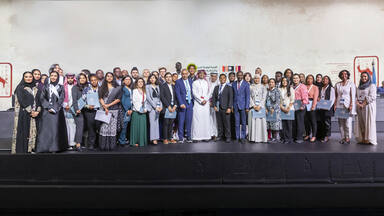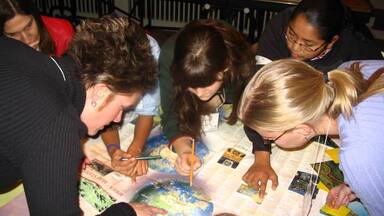World Heritage Youth Forum (2002) Sub-regional, First Central European Meeting
First Central European Meeting - World Heritage in Young Hands - in Bratislava, Slovakia, 24-29 June 2002.
The purpose of the meeting was to initiate innovative educational approach and develop a sense of shared responsibility for our common cultural and natural heritage. It is considered important to introduce cultural heritage education in both schools and out of school activities in order to enhance young people's positive attitude towards its conservation and safeguarding. It is in learning to appreciate and value our own heritage that the young people can learn to appreciate also the heritage of other cultures.
Recommendation
We the participants of the First Central European meeting "World Heritage in Young Hands" from Austria, Czech Republic, Hungary, Poland, Slovakia and Slovenia Bearing in mind:
- the outcome of the 30th anniversary of the Convention Concerning the Protection of the World Cultural and Natural Heritage;
- the Convention's contribution towards mutual understanding, peace, communication and regional integration;
- the importance of involving the youth in the process of protecting the world heritage at regional and subregional levels and developing a sense of shared responsibility for our common heritage.
- that world heritage sites are assets held in trust to pass on to future generations as their rightful inheritance and source of knowledge.
strongly recommend that :
- the world heritage sites are not just "show case" sites, but managers and owners are encouraged to develop programs that engage teachers and students in discussion that considers their future survival, and allow them an active interaction with those sites;
- the world heritage sites become a source of knowledge; pride and self-accomplishment for the young generation;
- the world heritage sites set standards of educational approaches for other heritage sites;
- the world heritage sites seen in the context of historical evolution, recognizing that other cultures and nationalities may also identify with the site;
- the world heritage sites linked with conflict are reconsidered and represented in a new context that enables global understanding;
- the ministers of education and culture take appropriate steps to introduce world heritage into the school curriculum of their respective countries;
- UNESCO takes immediate steps to assist both teachers and students by providing updated world heritage information on the Internet which:
- demonstrates ongoing projects in their own country and other countries;
- gives advice on how teachers can integrate the world heritage into the school curriculum;
- enables schools to exchange their experiences with other schools.
Outcome
The world heritage as a bridge of understanding and cooperation was used in order to create a link between our neighboring Central European countries. The young people got a variety of opportunities to learn how the study of the world heritage can help make us understand the world and the human and natural processes that continue to shape it. This understanding represents for us a basis upon which we endeavor to develop a more tolerant, peaceful and democratic world, with respect for human creativity manifesting itself everywhere, and this in particular through the preservation of the multicultural heritage and its message embodied in World Heritage List and numerous other sites. We and the other cooperating teams can build upon the stimulating experience of this meeting in everyday school practice and learning. Through the Bratislava Declaration also the UNESCO was delivered a constructive message and impulse that could a further support to the educators' and students' interaction in the field of cultural heritage all over the world.
Organizers
Foundation for Cultural Heritage Preservation in Bratislava/Slovakia
Slovak National Commission for UNESCO
Participants and observers
80 young people from the UNESCO Associated Schools (ASP) from the participating countries and their teachers.
Countries represented
Austria, Czech Republic, Hungary, Poland, Slovenia and Slovak Republic.
Activity Collaborators / Sponsors
- Ministry of Culture of the Slovak Republic
- International Visegrad Fund
- Hungarian National Commission for UNESCO
- Austrian National Commission for UNESCO
- Municipality of Bratislava
- Monument Preservation Office in Bratislava
- Municipal Museum in Bratislava
- Archaeological Institute of Slovak Academy of Sciences
- National Commissions for UNESCO of the participating countries

